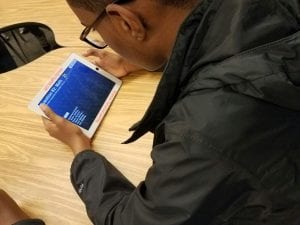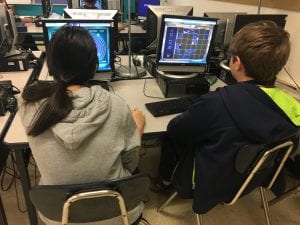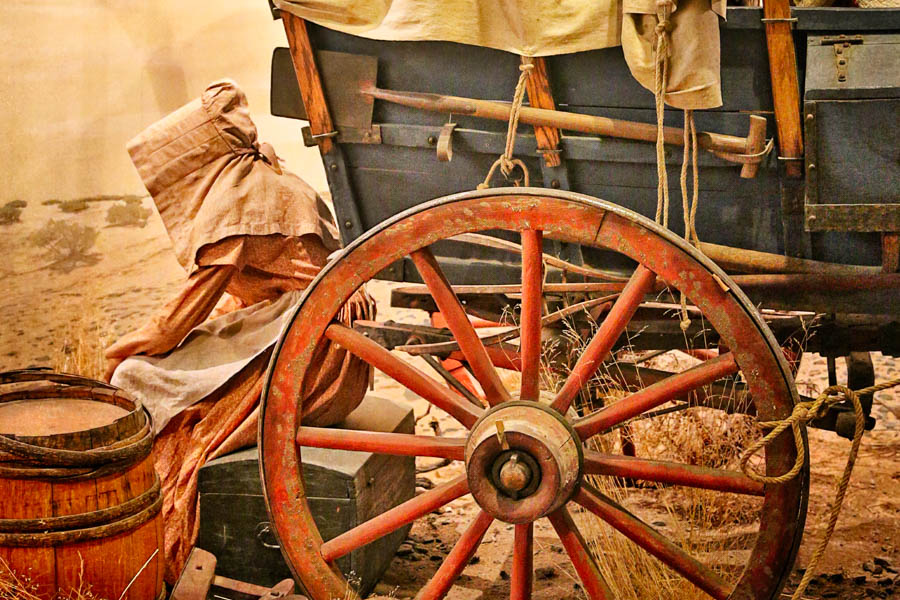The Power of Experiential Learning in Social Studies Class
Gather a group of folks of a certain age and mention the word “dysentery” and an interesting thing happens: eyes light up and people talk animatedly about wagons overturning in the river, sacks of beans and bad choices that led to everyone starving. An odd response for such a horrible disease, but of course it’s the reference to the game Oregon Trail that evokes such a deep seated, emotional response. What is it about Oregon Trail that had such a profound impact on so many of us that we clearly remember the experience years later?
Oregon Trail stemmed from the realization that kids learn more when they are learning about real people doing real things. Although we as teachers all know that deeper learning happens when students see and experience life and culture, time and curriculum constraints often limit social studies classes to focusing on major events, dates and important people. With the recent focus on STEM (and STEAM), social studies has taken a back seat, further limiting teaching resources. At Dig-iT! Games, we believe this is a dangerous oversight: STEM is absolutely vital to our kids’ success, but kids desperately need the tools that social studies courses provide. Our students need to learn to analyze, categorize, process and communicate, and evaluate the motivation behind an action. These skills have become even more critical in our current environment, where opinions are often mistaken for facts.

Captured at High Desert Museum Bend Oregon Photo Credit: Somedaytrips.com
It’s All About Experiences
Part of what made Oregon Trail such an effective teaching tool was that it was structured as a game. Playing wasn’t about passing a test, it was about finding a way to get little Mary and her family to the end without a catastrophe. Embedded in that experience was a variety of important information: certain foods are more nutritious or more durable than others; wagons are complicated machines that needed as
 much upkeep as a car does today; diseases were far more deadly in the past than they are now due to a lack of effective medication, etc. Learning was seamlessly blended with gameplay. Certainly, students learned about the dates the Oregon Trail was used, its geography and its significance, but they also had a first-hand look into the very real hardships of the people who used it. That emotional connection to historic events is extremely powerful, as evidenced by the number of people who remember what they learned from a short game they played as children decades ago.
much upkeep as a car does today; diseases were far more deadly in the past than they are now due to a lack of effective medication, etc. Learning was seamlessly blended with gameplay. Certainly, students learned about the dates the Oregon Trail was used, its geography and its significance, but they also had a first-hand look into the very real hardships of the people who used it. That emotional connection to historic events is extremely powerful, as evidenced by the number of people who remember what they learned from a short game they played as children decades ago.
The evidence shows that when one makes an implicit connection between information and themself, it is more likely the information is remembered later. Immersive games like Oregon Trail ask players, “What would you have done in that situation?” This is more powerful than just physically reading a textbook and absorbing the facts because of its emotional connection and cumulative learning effect. It forces students to draw on what they know and requires them to think differently about the information they’re receiving. They are able to see history as a story made up of patterns and repeating trends, not just a list of facts to memorize. That helps make the topic relevant to students and encourages them to apply those analytical skills to the world around them. When history becomes immediate instead of theoretical, it turns into an adventure instead of a chore. History taught in an immersive way helps students become engaged, excited and eager to learn more.
Why Use Digital Games?
As Oregon Trail illustrates, the value of a game is in what we take away from it, not in the game itself. It is in that individual engagement where electronic games win out over traditional games in a classroom setting. Digital games combine graphics, audio and movement into a coherent whole. These games are interactive and immersive, forcing the player to be truly invested in the outcome. Players are encouraged to strengthen weaker skills, while simultaneously taking advantage of their proficiencies. Electronic games level the playing field, allowing all learners to engage deeply and internalize ideas in the way that suits them best. So regardless of how a student best processes information, she/he will be able to learn the same thing as someone who operates differently.
 Our educational system is, unfortunately, not designed for individualized teaching. The cycle of lectures, mass-produced textbooks and standardized tests emphasizes consistency and conformity. Digital gaming can change that.
Our educational system is, unfortunately, not designed for individualized teaching. The cycle of lectures, mass-produced textbooks and standardized tests emphasizes consistency and conformity. Digital gaming can change that.
Digital games provide an environment where kids can learn at their own pace and in their own way. It’s much easier to admit strengths and weaknesses when no one is watching. Games are inherently flexible; they encourage experimentation, trial and error and failure. In no other learning environment are kids encouraged to fail and learn from their mistakes, even though every teacher knows the best way to learn something is by doing it (and failing a few times). The immediate feedback in games lets players determine for themselves what they need to do differently, allowing them to internalize the lesson. Students can practice skills they feel uncertain about, or move ahead to new things while the teacher focuses on students who are struggling with a topic. When students are put in an environment in which they can learn their way without fear of judgment or penalty, they become what every teacher strives for: independent learners.
What to Look For in a Game
Effective educational games bear certain hallmarks that should be known and considered. Here are a few key elements to look for in a solid learning game experience:
Purpose-aligned learning. Learning games that clearly show a student that they can use what they learn for a future purpose instill a level of confidence and willingness in that student that makes teaching and learning look effortless. Such games are carefully developed; look for those clearly aligned to a future purpose for the student and never again hear ‘But when am I ever going to need to know this?’
Content area knowledge. The gaming industry is crowded with games of every variety. While zombies and guns are popular, what you are looking for are those games that actually help a student along an academic course in science, social studies, music, art, etc., because ‘Zombie Hunter’ is not a real job listing. Scientist, educator, project manager, curator, artist are all real-world possibilities and while standards are a great guideline, more importantly, the future is what we make it.
Opportunities to explore. In educating a child, their self-determinism, the opportunity for them to look in wonder and to make a choice, one that they feel may be correct or interesting or one that merely satisfies their curiosity, is precious. Games provide a unique opportunity for children to explore and investigate things that are specifically of interest to them. There is a certain pleasure in learning new things, and even in going over the familiar, especially when one is in control of that learning. Look for games that provide the student situations in which they can choose a path forward and in which they control the level and pace of exposure to new information.
Multiple cognitive skills to problem solve. Even simple games engage multiple skills. Shooting zombies involves coordination, strategic thinking, and often collaboration with other players. Those skills are important, but literacy, mathematical knowledge, and comprehensive understanding of particular content are more useful in the long run. Good games are cross-curricular; they combine two or more curriculum areas into an engaging whole. These games put students in situations where they must draw on information and skills learned in multiple classes, an ability that will serve them well in college and the job market.
We Need Your Help!
Oregon Trail was groundbreaking when it was first introduced and continues to be the gold standard against which all history games are measured, but digital games have improved dramatically since its first introduction in the 80s. Certainly, graphics are much better quality now, but the biggest shifts have come on the data side: games track progress and some games allow teachers to see the student’s progress so they can tailor lessons or extra work to specific needs. Games are also easier to make and to distribute, both a positive and negative change: more games does not inherently mean better quality games and it is still a challenge to find games that align to a specific curriculum. We need your help to continue improving the quality and variety of games.
First, we want to know what you are teaching and where the gaps are. Do you have particular content areas you wish you had more resources for? For example, we know there is a lot of coverage for the Revolutionary War, but not so many resources for teaching Mesopotamia or ancient irrigation. We want to make high-quality games that help you engage your students better and follow your curriculum. If you have ideas for games or would like to be part of a discussion about key areas of curriculum you think games would be useful for, please email our Education Team (elisab@dig-itgames.com).
Secondly, we know Game-Based Learning (GBL) can be useful in the classroom but measuring the success is often challenging. Some games provide no learning outcomes and those that do are typically in proprietary systems requiring educators to log-into and learn separate learning management systems. Learning outcomes from one vendor cannot be easily compared with other games as there is no core standard. We believe that there is a need for a unified dashboard that standardizes the collection, reporting and analysis of learning outcomes across the GBL industry. We have received a grant from The National Science Foundation to develop this standard and build a unified dashboard. We want to know how data collection in games (or lack thereof) affects your thinking about GBL and your purchasing decisions. Additionally, we need your help developing a universal dashboard that reports data from multiple products in a useful way for your needs. If you would like to be part of this exciting project, please contact us (info@dig-itgames.com).
We hope you will participate in one or both of these initiatives. With your help we can move the game industry forward and create better products that match with your curricula and meet your data reporting needs.

A former archaeologist and middle school teacher, Suzi Wilczynski is the founder and CEO of Dig-iT! Games®, an independent developer of interactive educational games for kids. Through a seamless blend of fun and learning, Dig-iT! Games seeks to foster the joy of intellectual discovery and inspire kids to think differently about learning.

